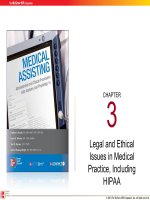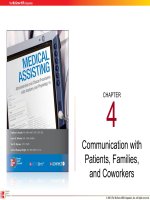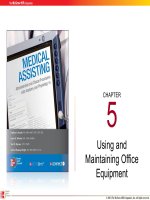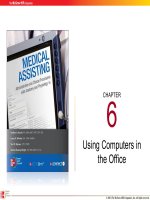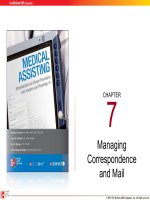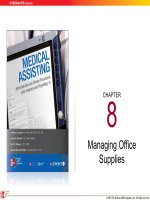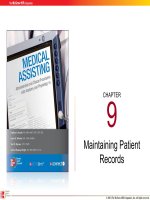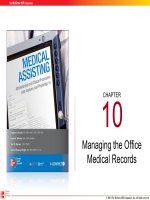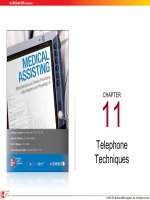Lecture Medical assisting: Administrative and clinical procedures with anatomy and physiology (4e) – Chapter 12
Bạn đang xem bản rút gọn của tài liệu. Xem và tải ngay bản đầy đủ của tài liệu tại đây (1.44 MB, 46 trang )
CHAPTER
12
Scheduling
Appointments and
Maintaining the
Physician’s Schedule
© 2011 The McGraw -Hill Com panies, Inc. A ll rights reserv e d.
12-2
Learning Outcomes
12.1 Explain the importance of the appointment book in
maintaining the schedule in the medical office.
12.2 Identify common scheduling abbreviations.
12.3 Identify different types of appointment scheduling
systems.
12.4 Discuss ways to arrange appointments for
patients.
© 2011 The McGraw -Hill Com panies, Inc. A ll rights reserv e d.
12-3
Learning Outcomes (cont.)
12.5 Explain how to handle special scheduling
situations.
12.6 Explain how to properly document no-shows and
late patients.
12.7 Describe how to schedule appointments that are
outside the medical office.
12.8 Discuss ways to keep an accurate and efficient
physician schedule.
© 2011 The McGraw -Hill Com panies, Inc. A ll rights reserv e d.
12-4
Introduction
• Scheduling systems
– Types
– How each is used
• Scheduling situations
• Appointment book
– Legal aspects
– Documentation
© 2011 The McGraw -Hill Com panies, Inc. A ll rights reserv e d.
12-5
The Appointment Book
A well-managed
appointment book
• Creates an efficient
patient flow
• Shows respect for
everyone’s time by
preventing excessive
wait time
Unexpected events
that occur
• Early and late arrivals
• No-show patients
• Emergencies
• Physicians spend
extra time with
patients
© 2011 The McGraw -Hill Com panies, Inc. A ll rights reserv e d.
12-6
The Appointment Book (cont.)
• Preparing the appointment
book
– Create the matrix, or basic
format
• Block off times the doctor
is unavailable
• Examples of when time should
be blocked off
–
–
–
–
Hospital rounds
Surgery
Vacation and holidays
Scheduled meetings
© 2011 The McGraw -Hill Com panies, Inc. A ll rights reserv e d.
12-7
The Appointment Book (cont.)
• Computer or traditional paper
appointment book
• Obtain patient information
– Patient’s full name
– Home and work telephone
numbers
– Purpose of the visit
• Use only approved
abbreviations
© 2011 The McGraw -Hill Com panies, Inc. A ll rights reserv e d.
12-8
Determining Standard Procedure Times
• Create a standard list of procedure
times
– Indicate how much time to allow for the
tests
– Use only as a guide
• Helps identify appointment openings
appropriate for the patient visit
© 2011 The McGraw -Hill Com panies, Inc. A ll rights reserv e d.
12-9
Determining Standard Procedure Times (cont.)
5-10 min
30–60 min
10-20 min
30 min
15–20 min
30 min or >
15-20 min
10–20 min
15-30 min
15 min
5–10 min
15–30 min
15 min
30 min
30 min or >
30-60 min
© 2011 The McGraw -Hill Com panies, Inc. A ll rights reserv e d.
12-10
A Legal Record
• Keep appointment books for at least 3 years
• Entries must be clear and easy to read
Never erase a name or use liquid paper
Use blue ink and never pencil
Draw a single line through the name
Write the date, time, and reason for cancellations
Document cancellations and no-shows in patient’s record
© 2011 The McGraw -Hill Com panies, Inc. A ll rights reserv e d.
12-11
Apply Your Knowledge
Use your knowledge of abbreviations and scheduling to
order these from least time required to most time required.
(1= least time required and 5= most time required)
3 S/R suture removal 10–20 min.
ANSWER:
5
CPE complete physical examination 30–60 min.
2
FU
1
CAN cancellation 0 min.
4
P&P Pap smear and pelvic examination 15–30 min.
follow-up appointment 5–10 min.
GOOD
JOB!
© 2011 The McGraw -Hill Com panies, Inc. A ll rights reserv e d.
12-12
Appointment Scheduling Systems
• Goals
– Smooth flow of patients
– Minimal waiting time
• Open-hours scheduling
– No appointments
• Patients arrive at their own
convenience
• Seen on a first-come, firstserved basis
– Rural practices and urgent
care centers
© 2011 The McGraw -Hill Com panies, Inc. A ll rights reserv e d.
12-13
Appointment Scheduling Systems
(cont.)
• Time-specified scheduling
– Stream scheduling
– Patients are scheduled for specific
times
• At regular intervals
• Time based on reason for the
appointment
© 2011 The McGraw -Hill Com panies, Inc. A ll rights reserv e d.
12-14
Appointment Scheduling Systems (cont.)
• Wave scheduling
– Large offices
• See several patients at the same time
• Seen in the order of their actual arrival
– Flexibility for appointments that run longer than
planned
– Uses an hourly target
• Number of patients to be seen hourly determined by
dividing 60 minutes by the average estimated length of
visits
– Multiple patients at the same time can result in
• Patient dissatisfaction
• Annoyance
© 2011 The McGraw -Hill Com panies, Inc. A ll rights reserv e d.
12-15
Appointment Scheduling Systems (cont.)
• Modified-wave scheduling
– Options
• Patients scheduled in 15-minute increments
• Four patients scheduled during the first half hour and the
second half hour is left free for catch-up
• Double-booking
– Two or more patients scheduled for the same time
• Both patients will see the doctor within the scheduled period
• One may be seen by NP or PA
– Used when patient with no appointment needs to be seen
© 2011 The McGraw -Hill Com panies, Inc. A ll rights reserv e d.
12-16
Appointment Scheduling Systems (cont.)
• Cluster scheduling (categorization)
– Groups similar appointments together
– Useful if specialized equipment has limited availability
• Advance scheduling
– Scheduling patients weeks or months in advance,
such as with annual exams
– Leave a few slots open for patients with unexpected
problems
• Combination scheduling – Using two scheduling
methods
© 2011 The McGraw -Hill Com panies, Inc. A ll rights reserv e d.
12-17
Appointment Scheduling Systems (cont.)
• Computerized scheduling – advantages
– Can “lock out” selected appointment times
– Information can be accessed from all office
terminals
– Help identify patients who are late, miss
appointments, cancel, or require more time with
the physician
– Reports to help improve efficiency
• Online scheduling – patients make own
appointments via the Internet
© 2011 The McGraw -Hill Com panies, Inc. A ll rights reserv e d.
12-18
Apply Your Knowledge
A large pediatrician office commonly must “squeeze in”
patients in that have become ill, so this new office plans
to offer immunizations only twice per week. Which
scheduling system(s) would you recommend for this
medical practice?
ANSWER: Combination scheduling consisting of
cluster and a form of wave scheduling would be
recommended to allow for the needed flexibility.
© 2011 The McGraw -Hill Com panies, Inc. A ll rights reserv e d.
12-19
Arranging Appointments
• Offer choices
– Dates
– Times
• Accommodate patient’s needs
whenever possible
• Confirm choice with patient
© 2011 The McGraw -Hill Com panies, Inc. A ll rights reserv e d.
12-20
Arranging Appointments (cont.)
• New patients
– Those not established
at the medical office
– Obtain all necessary
information
• Return appointments
– Ask patients if they
need another
appointment before
they leave
• Name
• Address and phone
number
• Date of birth
• Insurance information
– Have patient arrive
15–30 minutes early to
fill out forms
© 2011 The McGraw -Hill Com panies, Inc. A ll rights reserv e d.
12-21
Arranging Appointments (cont.)
Appointment cards
After appointment
time is entered in the
book, it is recorded
and given to the
patient
Reminder calls
1–2 days before the
scheduled appointment,
the office calls the
patient
Reminder mailings
Appointment
Reminders
A postcard
addressed to the
patient that is
mailed one week
before the
appointment
Recall notices
Form letter sent to
remind patients to
call for an
appointment
© 2011 The McGraw -Hill Com panies, Inc. A ll rights reserv e d.
12-22
Apply Your Knowledge
The doctor wants Mr. Lincoln to return to the office for a
follow-up appointment in two weeks. What should the
medical assistant do?
ANSWER: The medical assistant should offer Mr. Lincoln a
choice of dates and times available to accommodate Mr.
Lincoln’s needs. After entering the appointment in the
book or into the computer, confirm the date and time with
the patient and give him a appointment card.
TERRIFIC!
© 2011 The McGraw -Hill Com panies, Inc. A ll rights reserv e d.
12-23
Special Scheduling Situations: Patient
• Emergencies
– Seen immediately upon arrival at the office
– Explain to waiting patients without details
• Provide opportunity to reschedule
• Referrals
– Referred patients should be seen as soon as possible
– When arranging referrals for a patient
• Provide choices
• Be sure the facility accepts the patient’s insurance
• Document in patient record
© 2011 The McGraw -Hill Com panies, Inc. A ll rights reserv e d.
12-24
Special Scheduling Situations: Patient (cont.)
• Fasting patients
– Refrain from eating or drinking – usually
beginning the night before the appointment
– Schedule as early as possible in the day
– Instruct patient about the need to fast and
when to start
© 2011 The McGraw -Hill Com panies, Inc. A ll rights reserv e d.
12-25
Special Scheduling Situations: Patient (cont.)
• Patients with diabetes
– Require regular meals and snacks to regulate
blood glucose
– Consider avoiding late morning slots that are
close to lunchtime
– Keep appropriate snacks on hand
in the event a patient develops a
low blood sugar
© 2011 The McGraw -Hill Com panies, Inc. A ll rights reserv e d.

